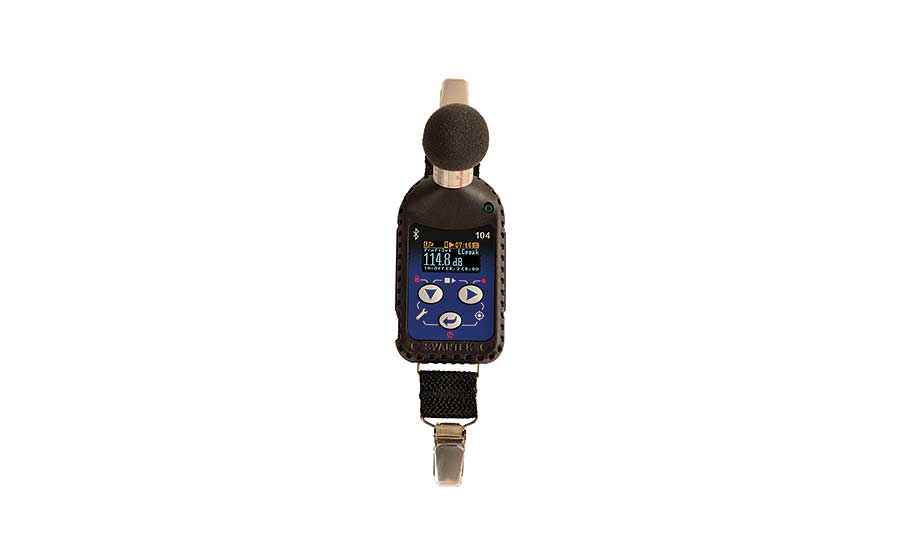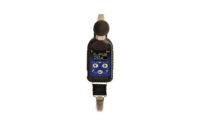A personal noise dosimeter is the instrument of choice to measure the employee’s workplace noise exposure. Designs of noise dosimeters have evolved over the years from instruments that used to be worn on the belt with a cable microphone on the shoulder to now where the whole instrument is small enough to be worn on the shoulder during the shift. Earlier dosimeters provided a dose reading as a percentage of the allowable limit based on 100 percent representing the equivalent of 90 dB for a standard day.
While this single number approach is enough to satisfy the requirements of the regulations, a single overall number hides a multitude of information that can help to understand the noise exposure in more detail. The addition of time history samples collected at regular intervals during the day helps to show the noisier parts of the day and so provide the industrial hygienist with valuable information about when and where to concentrate active noise control or the provision of hearing protection to best effect. Most noise dosimeters now provide time history information, but on its own it may not always be that useful.
Incomplete information
In many situations even the provision of time history samples is not the whole story:
- Limited memory in an instrument often allows just one-minute sampling to be performed. What about those samples that show much higher levels than expected? Is that one-minute peak level of 145 dB a real result due to an unexpected impact at work or did something else happen?
- Since the hygienist was not there with the instrument all day to witness what was going on at all times it is often necessary to rely on asking the worker “what happened at such and such a time yesterday during the measurement?” Not all workers can remember with any degree of accuracy what was happening at a specific time of the day. Even if they could remember where they were they may not recall what the dominant source of the noise was.
- Multiple events will get averaged out during a minute sample providing a single result that can hide the effect of different sources. Shorter sampling intervals will be more useful to resolve the real nature of the noise climate in all but the steadiest of noise exposure time histories. But shorter sampling intervals come at the expense of needing more memory which until recently had been relatively expensive to provide.
- What about the apparent peaks of noise revealed in a time history that show unexpected high levels when the noise climate should have none of that due to the known nature of the work being carried out? Could it be likely that the high indicated noise levels are not in fact due to acoustic events but perhaps from mechanical events such as knocking the microphone when working in a tight spot while the operator is moving around?
- Occasionally the worker may take the dosimeter off during the day and put it down somewhere and not be wearing it while they are working. As long as the worker is still nearby this is probably not too much of a problem. But what happens when the worker takes it off and places it on a bench next to a noisy machine and then goes somewhere else entirely. The supervisor will have no way of knowing what the true noise exposure was if they assume that the worker had the dosimeter on all the work day.
- If there was some way to positively identify the noise sources then a more educated estimate could be made about whether to keep a particular noise sample in the overall calculation or not. Once the dB sample has been obtained all information about the true identity of the noise is lost. With it goes all the useful information to make an accurate decision about the validity of that sample. Unless the supervisor was with the worker all the day to watch what happened they would not know what the true cause of any specific noise during the day actually was.
As we can see, there are many potential pitfalls for even the most attentive industrial hygienist trying to accurately estimate a worker’s true exposure to noise in the workplace.
Potential solutions
- Shorter sampling increments are now possible with some dosimeters able to save results as fast as 10 times per second. This can be very useful for the study of transient noise climates with lots of impulses in them.
- Knocks and bumps on the dosimeter caused by deliberate or accidental mechanical events on the dosimeter body are monitored by a built in self-vibration sensor that will tag the individual samples in the measurement that are potentially corrupted. The software can then be used to remove them to get valid results.
- The same self-vibration sensor can be used to tag the samples when the dosimeter is not moving at all during the run such as when it is put down on an object like a workbench. The vibration sensor is sensitive enough to be able to detect the slightest movement of the worker even sitting a desk not doing anything too active and hence indicate that it was not being worn.
- Newer dosimeters have options for real time audio recording of the actual microphone signal during the measurement when the noise level exceeds a trigger level. This can be saved and then listened to by the hygienist during the report generation to positively identify what was really happening at that time. This frees the hygienist from having to be with the worker all through the day to listen to what was happening all the time.
- Newer dosimeters now offer on board real time octave bands at every sample interval during the day to make sure that not only is the overall A weighted level stored but the spectral content of the noise is also saved. This is very important for the correct provision of suitable hearing protectors or noise control purposes.





